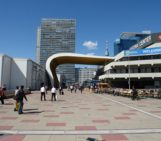
In the past weeks you have met the president, deputy president and one science officer of the Geodesy division. Last but not least, we introduce you today to the second science officer: Xavier Collilieux. He also answered a few questions for us (including where his favourite place in Vienna is). Curious to find out? Then read below.
 What is your position within the EGU and/or the Geodesy Division?
What is your position within the EGU and/or the Geodesy Division?
I am a science officer like Anna Kłos whom you interviewed last week!
What are your duties as a Science Officer?
Annette, our division president, can request help from us at any time, for example when assessing the EGU session program and the submitted abstract numbers to decide if some sessions should be merged. Science officers are also members of the “Outstanding Early Career Scientists Award” committee that selects the awardees.
What was your motivation to say yes when Annette asked you to be a Science Officer within the Geodesy Division?
It was an opportunity to see the organization of such a big meeting from inside, especially because I enjoy participating to the EGU. Good science and the wonderful city of Vienna!
What is the most exciting part of this job for you?
It is interesting to work with other scientists that I did not know before. The team is very motivated, especially the early career scientist representatives. Thanks for making this channel alive!
Give us a quick overview of your professional career so far!
I did my PhD at the geodesy lab of the French mapping agency (IGN France). I investigated systematic errors in geodetic station coordinate time series: I continued this activity for 4 years afterwards. I then moved to the geodesy operational department for a more traditional geodesy job in a team of highly trained surveyors. Since 2016, I am a teacher/researcher in geodesy at the French national school of geomatics called ENSG-Geomatics.
Currently, what are your research topics?
I am involved in the International Terrestrial Reference System (ITRS) centre activities to compute and design more accurate Terrestrial Reference Frames. Not real research topic yet, but I am learning InSAR processing at the moment, which is also of interest for my teaching activities.
What is your favorite food?
“Asparagus with sauce hollandaise”, a typical meal you can eat while at an EGU meeting in Vienna!
Do you have a favourite place in Vienna?
Yes, the Hundertwasserhaus! I am not sure I would like to live inside but I am used to visit the area almost every time I attend an EGU meeting!
Now you have been able to get to know the entire Geodesy division team that started at the EGU General Assembly 2021. But this is not the end of the interview series and we have one interview left. Find out who we have talked to as well in the coming weeks.




